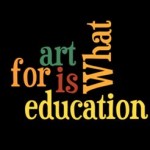
Arnold Aprill
What is Art Education For? An Assessment Checklist
Posted by Feb 19, 2014 3 comments

Arnold Aprill
 Art education in schools exists, to the extent that it exists at all, within the contexts of wider school cultures. School cultures are currently in the thrall of high stakes—undifferentiated, system-wide models of measurement and accountability. How does art education function in such an environment? Not so well.
Art education in schools exists, to the extent that it exists at all, within the contexts of wider school cultures. School cultures are currently in the thrall of high stakes—undifferentiated, system-wide models of measurement and accountability. How does art education function in such an environment? Not so well.
Because models for assessing arts learning are underdeveloped, the arts come to represent for many students a safe haven from relentless testing. At the same time, the arts are broadly discounted by policy makers as not being serious enough disciplines worthy of time, attention, or funding, because they are untested.
How might we find our way through the labyrinth of this double-bind? One approach is to look at the metaphors that undergird approaches to assessment at the policy level.
Bush Era “No Child Left Behind”: Known colloquially as “NCLB”, and sometimes as “Nickleby” (I’m thinking of the cruel Uncle Ralph Nickleby, not the sweet and brave hero in Dickens’ novel Nicholas Nickleby). NCLB in a nutshell is schools and individual teachers that do not demonstrate Annual Yearly Progress (AYP) on standardized test scores risk losing their funding or their jobs. The problem that I have always had with NCLB is implicit in the name itself. The policy is not named something like EPIC (Enhancing the Powers in Children). The policy is named “No Child Left Behind” – conjuring up an image of abandoned loser children and of winner children schlepped along to the  goalposts of achievement. This is not a metaphor representing child agency, child capacity, child initiative, or child power. Learning in this model is not something that children do, but rather is something done to them. The core metaphor here is a “potato race”–a game in which competitors (teachers) carry inert potatoes (lumpy and lumpen children) precariously balanced on spoons as they rush back and forth across a finish line, dropping some potatoes and depositing others in a heap to win.
goalposts of achievement. This is not a metaphor representing child agency, child capacity, child initiative, or child power. Learning in this model is not something that children do, but rather is something done to them. The core metaphor here is a “potato race”–a game in which competitors (teachers) carry inert potatoes (lumpy and lumpen children) precariously balanced on spoons as they rush back and forth across a finish line, dropping some potatoes and depositing others in a heap to win.
Obama Era “Race to the Top”, or R2T: A contest between states and local districts for big bucks, with points given for evidence of such things as intervening in low achieving schools, demonstrating significant progress in raising achievement and in closing gaps, developing charter schools, privatization of public services, and computerization. The metaphor for R2T is as the name says, a race, but while NCLB was a horizontal race, Race to the Top is a vertical race; a climbing wall. Again, we have a metaphor built around winners and losers, but this time among states and districts rather than schools and teachers. A level up in the policy food supply chain and a quantum leap away from children, parents, and teachers.
 Rhizomes: There is another metaphor, developed by Félix Guattari and Gilles Deleuze, which is emerging as a useful tool for rethinking social systems like school districts. This is the “rhizome” – networks of biological roots that expand out, grow up, and draw sustenance from and in many directions. This metaphor opposes linear, dualist thinking (dubbed “arborescent” by Guattari and Deleuze based on the image of a tree with a siloed root system and one trunk.)
Rhizomes: There is another metaphor, developed by Félix Guattari and Gilles Deleuze, which is emerging as a useful tool for rethinking social systems like school districts. This is the “rhizome” – networks of biological roots that expand out, grow up, and draw sustenance from and in many directions. This metaphor opposes linear, dualist thinking (dubbed “arborescent” by Guattari and Deleuze based on the image of a tree with a siloed root system and one trunk.)











Most Commented